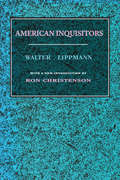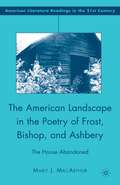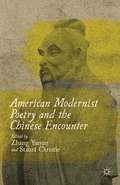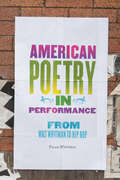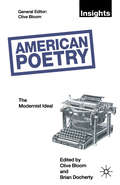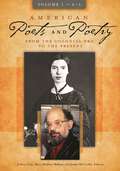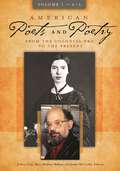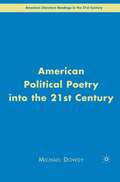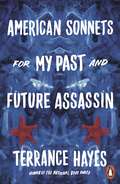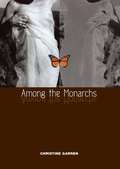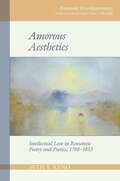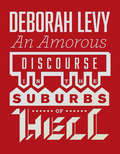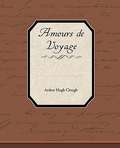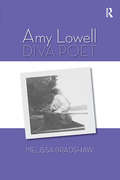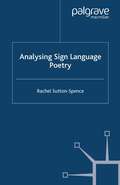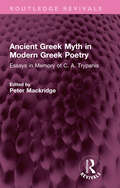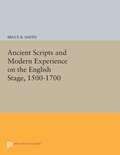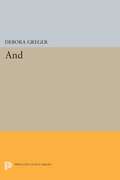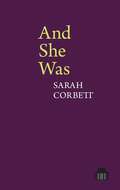- Table View
- List View
American Inquisitors
by Walter LippmannAmerican Inquisitors is one of the small gems among Walter Lippmann's larger books. Written in response to the trials of John Scopes and William McAndrew in 1925 and 1927, this volume contains a succinct analysis of a basic problem of democracy: the conflict between intellectual freedom and majority rule. In both cases, the state, acting in the name of popular sovereignty, sought to suppress teaching that was contrary to the tenets of religious fundamentalism and patriotic tradition. In distilling the arguments surrounding both trials, Lippmann sounds a warning against the tyranny of the majority and challenges people to rethink their theories of liberty and democracy.American Inquisitors consists of five related dialogues, each exploring a different dilemma at the heart of democratic political theory. The first two establish the principles of majority rule and freedom of the mind in the persons of William Jennings Bryan and Thomas Jefferson, with Socrates urging a reexamination of all principles..These dialogues debate the will and the rational capacity of the people to rule and demonstrate the relative nature of freedom in democratic society.The third and fourth dialogues set a fundamentalist against a modernist and an Americanist against a scholar. Lippmann resists easy stereotyping and puts challenging insights and plausible arguments into the mouths of all the parties. These dialogues ask whether commitment to community comes before intellectual inquiry, 'or whether the search for truth precedes identity. The final dialogue, between Socrates and a conscientious teacher, attempts to define the mission of teaching and determine when and how to face the consequences of truth. Lippmann concludes that the program of liberty is to deprive the sovereign of absolute and arbitrary rule. Taken as a whole, the dialogues constitute an essential consistency within Lippmann's political thought, and delineate a recurring problem hi American politcal culture. American Inquisit
American Inquisitors
by Walter LippmannAmerican Inquisitors is one of the small gems among Walter Lippmann's larger books. Written in response to the trials of John Scopes and William McAndrew in 1925 and 1927, this volume contains a succinct analysis of a basic problem of democracy: the conflict between intellectual freedom and majority rule. In both cases, the state, acting in the name of popular sovereignty, sought to suppress teaching that was contrary to the tenets of religious fundamentalism and patriotic tradition. In distilling the arguments surrounding both trials, Lippmann sounds a warning against the tyranny of the majority and challenges people to rethink their theories of liberty and democracy.American Inquisitors consists of five related dialogues, each exploring a different dilemma at the heart of democratic political theory. The first two establish the principles of majority rule and freedom of the mind in the persons of William Jennings Bryan and Thomas Jefferson, with Socrates urging a reexamination of all principles..These dialogues debate the will and the rational capacity of the people to rule and demonstrate the relative nature of freedom in democratic society.The third and fourth dialogues set a fundamentalist against a modernist and an Americanist against a scholar. Lippmann resists easy stereotyping and puts challenging insights and plausible arguments into the mouths of all the parties. These dialogues ask whether commitment to community comes before intellectual inquiry, 'or whether the search for truth precedes identity. The final dialogue, between Socrates and a conscientious teacher, attempts to define the mission of teaching and determine when and how to face the consequences of truth. Lippmann concludes that the program of liberty is to deprive the sovereign of absolute and arbitrary rule. Taken as a whole, the dialogues constitute an essential consistency within Lippmann's political thought, and delineate a recurring problem hi American politcal culture. American Inquisit
The American Landscape in the Poetry of Frost, Bishop, and Ashbery: The House Abandoned (American Literature Readings in the 21st Century)
by M. MacArthurRobert Frost, Elizabeth Bishop, and John Ashbery stand out among major American poets - all three shaped the direction and pushed the boundaries of contemporary poetry on an international scale. Drawing on biography, cultural history, and original archival research, MacArthur shows us that these distinctive poets share one surprisingly central trope in their oeuvres: the Romantic scene of the abandoned house. This book scrutinizes the popular notion of Frost as a deeply rooted New Englander, demonstrates that Frost had an underestimated influence on Bishop - whose preoccupation with houses and dwelling is the obverse of her obsession with travel - and questions dominant, anti-biographical readings of Ashbery as an urban-identified poet. As she reads poems that evoke particular landscapes and houses lost and abandoned by these poets, MacArthur also sketches relevant cultural trends, including patterns of rural de-settlement, the transformation of rural economies from agriculture to tourism, and modern American s increasing mobility and rootlessness.
American Modernist Poetry and the Chinese Encounter
by Zhang Yuejun and Stuart ChristieAmerican Modernist Poetry and the Chinese Encounteroffers a framework for understanding the variety of imagined encounters by eight different American poets with their imagined 'Chinese' subject. The method is historical and materialist, insofar as the contributors to the volume read the claims of specific poems alongside the actual and tumultuous changes China faced between 1911 and 1979. Even where specific poems are found to be erroneous, the contributors to the volume suggest that each of the poets attempted to engage their 'Chinese' subject with a degree of commitment that presaged imaginatively China's subsequent dominance. The poems stand as unique artifacts, via proxy and in the English language, for the rise of China in the American imagination. The audience of the volume is international, including the growing number of scholars and graduate students in Chinese universities working on American literature and comparative cultural studies, as well as already established commentators and students in the west.
American Poetry in Performance: From Walt Whitman to Hip Hop
by Tyler Hoffman"Tyler Hoffman brings a fresh perspective to the subject of performance poetry, and this comes at an excellent time, when there is such a vast interest across the country and around the world in the performance of poetry. He makes important connections, explaining things in a manner that remains provocative, interesting, and accessible." ---Jay Parini, Middlebury College American Poetry in Performance: From Walt Whitman to Hip Hop is the first book to trace a comprehensive history of performance poetry in America, covering 150 years of literary history from Walt Whitman through the rap-meets-poetry scene. It reveals how the performance of poetry is bound up with the performance of identity and nationality in the modern period and carries its own shifting cultural politics. This book stands at the crossroads of the humanities and the social sciences; it is a book of literary and cultural criticism that deals squarely with issues of "performance," a concept that has attained great importance in the disciplines of anthropology and sociology and has generated its own distinct field of performance studies. American Poetry in Performance will be a meaningful contribution both to the field of American poetry studies and to the fields of cultural and performance studies, as it focuses on poetry that refuses the status of fixed aesthetic object and, in its variability, performs versions of race, class, gender, and sexuality both on and off the page. Relating the performance of poetry to shifting political and cultural ideologies in the United States, Hoffman argues that the vocal aspect of public poetry possesses (or has been imagined to possess) the ability to help construct both national and subaltern communities. American Poetry in Performance explores public poets' confrontations with emergent sound recording and communications technologies as those confrontations shape their mythologies of the spoken word and their corresponding notions about America and Americanness.
American Poetry: The Modernist Ideal (Insights)
by Clive Bloom Brian DochertyTracing its origins back to Walt Whitman, the Modernist tradition in American poetry is driven by the same concern to engage with the world in revolutionary terms, inspired by the concept of democracy vital to the American dream. But this tradition is not confined to a few writers at the beginning of the century: instead it has been an enduring force, extending from coast to coast and of varying hues: Imagist, Objectivist, Beat. International in flavour but shaped by the language and conditions of America, this poetry continues to speak to us today. This collection of specially commissioned essays brings together leading scholars and critics to define the American Modernist canon, providing a range of perspectives helpful to all those interested in this fascinating poetry.
American Poets and Poetry [2 volumes]: From the Colonial Era to the Present [2 volumes]
by Jeffrey Gray Mary McAleer Balkun James McCorkleThe ethnically diverse scope, broad chronological coverage, and mix of biographical, critical, historical, political, and cultural entries make this the most useful and exciting poetry reference of its kind for students today.American poetry springs up out of all walks of life; its poems are "maternal as well as paternal…stuff'd with the stuff that is coarse and stuff'd with the stuff that is fine," as Walt Whitman wrote, adding "Of every hue and caste am I, of every rank and religion." Written for high school and undergraduate students, this two-volume encyclopedia covers U.S. poetry from the Colonial era to the present, offering full treatments of hundreds of key poets of the American canon. What sets this reference apart is that it also discusses events, movements, schools, and poetic approaches, placing poets in their social, historical, political, cultural, and critical contexts and showing how their works mirror the eras in which they were written. Readers will learn about surrealism, ekphrastic poetry, pastoral elegy, the Black Mountain poets, and "language" poetry. There are long and rich entries on modernism and postmodernism as well as entries related to the formal and technical dimensions of American poetry.Particular attention is paid to women poets and poets from various ethnic groups. Poets such as Amiri Baraka, Nathaniel Mackey, Natasha Trethewey, and Tracy Smith are featured. The encyclopedia also contains entries on a wide selection of Latino and Native American poets and substantial coverage of the avant-garde and experimental movements and provides sidebars that illuminate key points.
American Poets and Poetry [2 volumes]: From the Colonial Era to the Present [2 volumes]
by Jeffrey Gray Mary McAleer Balkun James McCorkleThe ethnically diverse scope, broad chronological coverage, and mix of biographical, critical, historical, political, and cultural entries make this the most useful and exciting poetry reference of its kind for students today.American poetry springs up out of all walks of life; its poems are "maternal as well as paternal…stuff'd with the stuff that is coarse and stuff'd with the stuff that is fine," as Walt Whitman wrote, adding "Of every hue and caste am I, of every rank and religion." Written for high school and undergraduate students, this two-volume encyclopedia covers U.S. poetry from the Colonial era to the present, offering full treatments of hundreds of key poets of the American canon. What sets this reference apart is that it also discusses events, movements, schools, and poetic approaches, placing poets in their social, historical, political, cultural, and critical contexts and showing how their works mirror the eras in which they were written. Readers will learn about surrealism, ekphrastic poetry, pastoral elegy, the Black Mountain poets, and "language" poetry. There are long and rich entries on modernism and postmodernism as well as entries related to the formal and technical dimensions of American poetry.Particular attention is paid to women poets and poets from various ethnic groups. Poets such as Amiri Baraka, Nathaniel Mackey, Natasha Trethewey, and Tracy Smith are featured. The encyclopedia also contains entries on a wide selection of Latino and Native American poets and substantial coverage of the avant-garde and experimental movements and provides sidebars that illuminate key points.
American Political Poetry in the 21st Century (American Literature Readings in the 21st Century)
by M. DowdyDowdy uncovers and analyzes the primary rhetorical strategies, particularly figures of voice, in American political poetry from the Vietnam War-era to the present. He brings together a unique and diverse collection of poets, including an innovative section on hip hop performance.
American Sonnets for My Past and Future Assassin (Penguin Poets Ser.)
by Terrance HayesThe black poet would love to say his century beganWith Hughes or God forbid, Wheatley, but actuallyIt began with all the poetry weirdos & worriers, warriors,Poetry whiners & winos falling from ship bows, sunsetBridges & windows. In a second I'll tell you how littleWriting rescues.So begins this astonishing, muscular sequence by one of America's best-selling and most acclaimed poets. Over 70 poems, each titled 'American Sonnet for my Past and Future Assassin' and shot through with the vernacular energy of popular culture, Terrance Hayes manoeuvres his way between touching domestic visions, stories of love, loss and creation, tributes to the fallen and blistering denunciations of the enemies of the good.American Sonnets builds a living picture of the whole self, and the whole human, even as it opens to the view the dividing lines of race, gender and political oppression which define the early 21st Century. It is compassionate, hilarious, melancholy, bewildered - and unstoppably, rhythmically compelling, as few books can hope to be.
Among The Monarchs (Phoenix Poets Ser.)
by Christine GarrenIn poems of haunting lyricism, and in a voice wholly unlike any other American poet, Christine Garren's second book of poetry explores common themes such as love, loss, and family with an uncommon sensibility. Among the Monarchs is filled with unforgettable metaphors, unconventional and unpredictable juxtapositions, turns and angles of perception, and seductive free verse rhythms. Through all of this, Garren captivates readers in a unique exploration of the nature of desire, the raptures and burdens of love and loss, the peculiarities of family life and, perhaps most compelling, the power of poetic imagination to shape what we see and feel. At once engaging and disquieting, Among the Monarchs attests to the inexhaustible possibilities of lyric poetry.
Among the Monarchs (Phoenix Poets)
by Christine GarrenIn poems of haunting lyricism, and in a voice wholly unlike any other American poet, Christine Garren's second book of poetry explores common themes such as love, loss, and family with an uncommon sensibility. Among the Monarchs is filled with unforgettable metaphors, unconventional and unpredictable juxtapositions, turns and angles of perception, and seductive free verse rhythms. Through all of this, Garren captivates readers in a unique exploration of the nature of desire, the raptures and burdens of love and loss, the peculiarities of family life and, perhaps most compelling, the power of poetic imagination to shape what we see and feel. At once engaging and disquieting, Among the Monarchs attests to the inexhaustible possibilities of lyric poetry.
Amorous Aesthetics: Intellectual Love in Romantic Poetry and Poetics, 1788–1853 (Romantic Reconfigurations: Studies in Literature and Culture 1780-1850 #7)
by Seth T. RenoSituated at the intersection of affect studies, ecocriticism, aesthetics, and Romantic studies, this book presents a genealogy of love in Romantic-era poetry, science, and philosophy. While feeling and emotion have been traditional mainstays of Romantic literature, the concept of love is under-studied and under-appreciated, often neglected or dismissed as idealized, illusory, or overly sentimental. However, Seth Reno shows that a particular conception of intellectual love is interwoven with the major literary, scientific, and philosophical discourses of the period. Romantic-era writers conceived of love as integral to broader debates about the nature of life, the biology of the human body, the sociology of human relationships, the philosophy of nature, and the disclosure of being.Amorous Aesthetics traces the development of intellectual love from its first major expression in Baruch Spinoza’s Ethics, through its adoption and adaptation in eighteenth-century moral and natural philosophy, to its emergence as a Romantic tradition in the work of six major poets. From William Wordsworth and John Clare’s love of nature, to Percy Shelley’s radical politics of love, to the more sceptical stances of Felicia Hemans, Alfred Tennyson, and Matthew Arnold, intellectual love is a pillar of Romanticism.This book will interest scholars and students of Romanticism, eighteenth- and nineteenth-century British literature, affect studies, ecocriticism, aesthetics, and those who work at the intersection of literature and science.
An Amorous Discourse in the Suburbs of Hell
by Deborah LevyMan Booker Prize shortlisted Deborah Levy whips up a storm of romance and slapstick, of heavenly and earthly delights, in this dystopian philosophical poem about individualfreedom and the search for the good life.
Amours De Voyage
by Arthur Hugh CloughOver the great windy waters, and over the clear-crested summits, Unto the sun and the sky, and unto the perfecter earth, Come, let us go,--to a land wherein gods of the old time wandered, Where every breath even now changes to ether divine. <P> <P> Come, let us go; though withal a voice whisper, 'The world that we live in, Whithersoever we turn, still is the same narrow crib; 'Tis but to prove limitation, and measure a cord, that we travel; Let who would 'scape and be free go to his chamber and think; 'Tis but to change idle fancies for memories wilfully falser; 'Tis but to go and have been.'--Come, little bark! let us go.
Amy Lowell, Diva Poet
by Melissa BradshawIn her reassessment of Amy Lowell as a major figure in the modern American poetry movement, Melissa Bradshaw uses theories of the diva and female celebrity to account for Lowell's extraordinary literary influence in the early twentieth century and her equally extraordinary disappearance from American letters after her death. Recognizing Amy Lowell as a literary diva, Bradshaw shows, accounts for her commitment to her art, her extravagant self-promotion and self-presentation, and her fame, which was of a kind no longer associated with poets. It also explains the devaluation of Lowell's poetry and criticism, since a woman's diva status is always short-lived and the accomplishments of celebrity women are typically dismissed and trivialized. In restoring Lowell to her place within the American poetic renaissance of the nineteen-teens and twenties, Bradshaw also recovers a vibrant moment in popular culture when poetry enjoyed mainstream popularity, audiences packed poetry readings, and readers avidly followed the honors, exploits, and feuds of their favorite poets in the literary columns of daily newspapers. Drawing on a rich array of letters, memoirs, newspapers, and periodicals, but eschewing the biographical interpretations of her poetry that have often characterized criticism on Lowell, Bradshaw gives us an Amy Lowell who could not be further removed from the lonely victim of ill-health and obesity who appears in earlier book-length studies. Amy Lowell as diva poet takes her rightful place as a powerful writer of modernist verse who achieved her personal and professional goals without capitulating to heteronormative ideals of how a woman should act, think, or appear.
Amy Lowell, Diva Poet
by Melissa BradshawIn her reassessment of Amy Lowell as a major figure in the modern American poetry movement, Melissa Bradshaw uses theories of the diva and female celebrity to account for Lowell's extraordinary literary influence in the early twentieth century and her equally extraordinary disappearance from American letters after her death. Recognizing Amy Lowell as a literary diva, Bradshaw shows, accounts for her commitment to her art, her extravagant self-promotion and self-presentation, and her fame, which was of a kind no longer associated with poets. It also explains the devaluation of Lowell's poetry and criticism, since a woman's diva status is always short-lived and the accomplishments of celebrity women are typically dismissed and trivialized. In restoring Lowell to her place within the American poetic renaissance of the nineteen-teens and twenties, Bradshaw also recovers a vibrant moment in popular culture when poetry enjoyed mainstream popularity, audiences packed poetry readings, and readers avidly followed the honors, exploits, and feuds of their favorite poets in the literary columns of daily newspapers. Drawing on a rich array of letters, memoirs, newspapers, and periodicals, but eschewing the biographical interpretations of her poetry that have often characterized criticism on Lowell, Bradshaw gives us an Amy Lowell who could not be further removed from the lonely victim of ill-health and obesity who appears in earlier book-length studies. Amy Lowell as diva poet takes her rightful place as a powerful writer of modernist verse who achieved her personal and professional goals without capitulating to heteronormative ideals of how a woman should act, think, or appear.
Analysing Sign Language Poetry
by R. Sutton-SpenceThis new study is a major contribution to sign language study and to literature generally, looking at the complex grammatical, phonological and morphological systems of sign language linguistic structure and their role in sign language poetry and performance. Chapters deal with repetition and rhyme, symmetry and balance, neologisms, ambiguity, themes, metaphor and allusion, poem and performance, and blending English and sign language poetry. Major poetic performances in both BSL and ASL - with emphasis on the work of the deaf poet Dorothy Miles - are analysed using the tools provided in the book.
Ancient Greek Myth in Modern Greek Poetry: Essays in Memory of C. A. Trypanis (Routledge Revivals)
by Peter MackridgeOriginally published in 1996, this volume contains essays by scholars, critics and translators and includes themes such as the myth in the Cretan Renaissance and the use of ancient myth by 19th and 20th Century poets. Some essays deal with individual mythical figures such as Odysseus, Orpheus, Prometheus and Aphrodite, while others deal with the problematic issue of the use of myth by Greek women poets. The discussion is completed by comparing attitudes to the ancient Greeks as embodied in English and modern Greek poetry.
Ancient Greek Myth in Modern Greek Poetry: Essays in Memory of C. A. Trypanis (Routledge Revivals)
Originally published in 1996, this volume contains essays by scholars, critics and translators and includes themes such as the myth in the Cretan Renaissance and the use of ancient myth by 19th and 20th Century poets. Some essays deal with individual mythical figures such as Odysseus, Orpheus, Prometheus and Aphrodite, while others deal with the problematic issue of the use of myth by Greek women poets. The discussion is completed by comparing attitudes to the ancient Greeks as embodied in English and modern Greek poetry.
Ancient Poems, Ballads, and Songs of the Peasantry of England
by Robert BellRobert Bell edited Ancient Poems, Ballads, and Songs of the Peasantry of England. Robert Bell states in his preface his belief in the realism of the English peasantry. <P> <P> "The value of this volume consists in the genuineness of its contents, and the healthiness of its tone. While fashionable life was masquerading in imaginary Arcadias, and deluging theatres and concert rooms with shams, the English peasant remained true to the realities of his own experience, and produced and sang songs which faithfully reflected the actual life around him. Whatever these songs describe is true to that life. There are no fictitious raptures in them. Love here never dresses its emotions in artificial images, nor disguises itself in the mask of a Strephon or a Daphne. It is in this particular aspect that the poetry of the country possesses a permanent and moral interest."
Ancient Scripts and Modern Experience on the English Stage, 1500-1700 (PDF)
by Bruce R. SmithUnlike the contrast between the sacred and the taboo, the opposition of "comic" and "tragic" is not a way of categorizing experience that we find in cultures all over the world or even at different periods in Western civilization. Though medieval writers and readers distinguished stories with happy endings from stories with unhappy endings, it was not until the sixteenth and seventeenth centuries--fifteen hundred years after Sophocles, Euripides, Plautus, and Terence had last been performed in the theaters of the Roman Empire--that tragedy and comedy regained their ancient importance as ways of giving dramatic coherence to human events. Ancient Scripts and Modern Experience on the English Stage charts that rediscovery, not in the pages of scholars' books, but on the stages of England's schools, colleges, inns of court, and royal court, and finally in the public theaters of sixteenth-and seventeenth-century London.In bringing to imaginative life the scripts, eyewitness accounts, and financial records of these productions, Bruce Smith turns to the structuralist models that anthropologists have used to explain how human beings as social creatures organize and systematize experience. He sets in place the critical, physical, and social structures in which sixteenth-and seventeenth-century Englishmen watched productions of classical comedy and classical tragedy. Seen in these three contexts, these productions play out a conflict between classical and medieval ways of understanding and experiencing comedy's interplay between satiric and romantic impulses and tragedy's clash between individuals and society.Originally published in 1988.The Princeton Legacy Library uses the latest print-on-demand technology to again make available previously out-of-print books from the distinguished backlist of Princeton University Press. These editions preserve the original texts of these important books while presenting them in durable paperback and hardcover editions. The goal of the Princeton Legacy Library is to vastly increase access to the rich scholarly heritage found in the thousands of books published by Princeton University Press since its founding in 1905.
And (PDF)
by Debora GregerFrom the title poem:Ampersand pink as dead shrimp, the unborn curls in its tide pool--seed pearl whose mother lusters over irritant love it's too late to dislodge; little anemone, shrinking from touch. So and holds separate what it most closely binds.Review:"Ms. Greger's poems take place at the point of encounter between the mind and the world of matter. . . . And it is the resistance of the real and the increasing urgency the poet feels in trying to extinguish her solitude . . . that make these poems emotional."--The New York Times Book ReviewOriginally published in 1985.The Princeton Legacy Library uses the latest print-on-demand technology to again make available previously out-of-print books from the distinguished backlist of Princeton University Press. These editions preserve the original texts of these important books while presenting them in durable paperback and hardcover editions. The goal of the Princeton Legacy Library is to vastly increase access to the rich scholarly heritage found in the thousands of books published by Princeton University Press since its founding in 1905.
And She Was: A Verse-Novel (Pavilion Poetry)
by Sarah CorbettA soul’s journey through the night, a missing woman: time and narrative bend and interlock across a play of poetic forms and voices to make one story of love and loss. In And She Was Corbett combines the fictional spell-making of Haruki Murakami, with the filmic neo-noir of Atom Egoyan (Exotica) and David Lynch (Lost Highway, Mulholland Drive), to push the boundaries of poetic genre, asking us to renegotiate the way we encounter and reconfigure ourselves through trauma, in desire, or as we seek to reassemble ourselves and our past. November, 3am, and two young lovers are about to meet on the Heathrow Express. A side street in an unknown city: Felix Morning wakes with no memory. In his pocket is a membership card for a nightclub, The Bunker. With the help of the beautiful Flick, he must recover what he has lost. Deep into a dangerous love affair, Esther and Iain believe the other can replace what they each have lost – a heart, a gift – but is Esther’s price too high for Iain to pay, and can their love survive? Who is Esther, where has she come from, and what has she got to do with the woman in the labyrinth? Does Flick belong to the past or to the future? What is memory, and what remains of us without it? And She Was demands our attention, its startling and dazzling writing asking us to be carried away as we read, but returning us by its end to a place both resolved and transformed.
And She Was: A Verse-Novel (Pavilion Poetry)
by Sarah CorbettA soul’s journey through the night, a missing woman: time and narrative bend and interlock across a play of poetic forms and voices to make one story of love and loss. In And She Was Corbett combines the fictional spell-making of Haruki Murakami, with the filmic neo-noir of Atom Egoyan (Exotica) and David Lynch (Lost Highway, Mulholland Drive), to push the boundaries of poetic genre, asking us to renegotiate the way we encounter and reconfigure ourselves through trauma, in desire, or as we seek to reassemble ourselves and our past. November, 3am, and two young lovers are about to meet on the Heathrow Express. A side street in an unknown city: Felix Morning wakes with no memory. In his pocket is a membership card for a nightclub, The Bunker. With the help of the beautiful Flick, he must recover what he has lost. Deep into a dangerous love affair, Esther and Iain believe the other can replace what they each have lost – a heart, a gift – but is Esther’s price too high for Iain to pay, and can their love survive? Who is Esther, where has she come from, and what has she got to do with the woman in the labyrinth? Does Flick belong to the past or to the future? What is memory, and what remains of us without it? And She Was demands our attention, its startling and dazzling writing asking us to be carried away as we read, but returning us by its end to a place both resolved and transformed.
